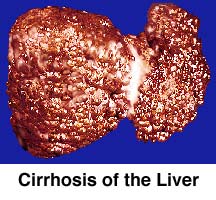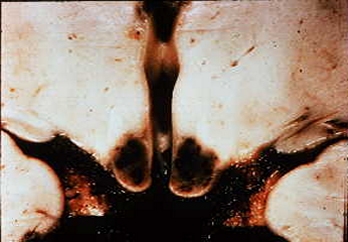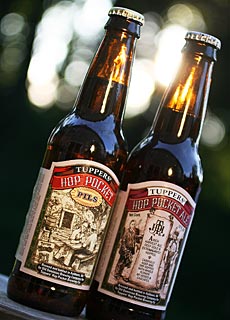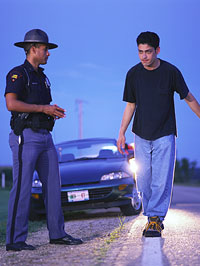



|
|
The dangers of alcohol are numerous and include a wide variety of consequences and circumstances that lead to those consequences. One such danger is drunk driving or drinking under the influence, which is considered a federal offense.
Alcohol's Effects
The effects of short-term alcoholism are:
The body responds to alcohol in different stages corresponding with the blood alcohol content (BAC), or blood alcohol concentration.
People with a BAC of 0.03 to 0.12 percent are in a state of euphoria. They become more self-confident or daring, and their judgment is not as good. They have trouble with fine movements, such as writing or signing their name. Their attention span shortens. They may look flushed.
People with a BAC of 0.09 to 0.25 percent are in a state of excitement. Ironically, in this "excitement", they become sleepy. They have trouble understanding or remembering things (even recent events). They do not react to situations as quickly, their body movements are uncoordinated, and they begin to lose their balance easily. Their vision becomes blurry, and they may have trouble sensing things (hearing, tasting, feeling, etc.).
People with a BAC of 0.18 to 0.30 percent are in a state of confusion. They are confused and might not know where they are or what they are doing. They are dizzy or sleepy and may stagger. They have unclear vision, slurred speech, and uncoordinated movements (trouble catching an object thrown to them). They may be highly emotional, aggressive, withdrawn or overly affectionate.
People with a BAC of 0.25 to 0.4 percent are in a state of stupor. They can barely move at all. They cannot respond to stimuli, stand, or walk. They may vomit and lapse in and out of consciousness.
People with a BAC of 0.35 to 0.50 percent are in coma. They are unconscious and their reflexes are depressed. Their body temperature is lower than normal, their breathing is slower and more shallow, and their heart rate may slow. They may die.
When a person reaches a BAC of 0.5 or more, the central nervous system fails, resulting in death. A report by the Journal of American Medical Association stated that alcohol was the cause of 85,000 deaths in the United States (3.5% of total U.S. deaths).
The effects of long-term alcoholism include:
- death from many sources, mainly alcohol toxemia
- pancreatitis, or inflammation of the pancreas (both the acute and chronic form)
- heart disease, including dilated cardiomyopathy
- polyneuropathy, or damage to the nerves leading to poor sensation of pain and impaired mobility
- cirrhosis of the liver, a chronic disease characterized by destruction of liver cells and loss of liver function, and its numerous complications, including bleeding from esophageal varices
- depression, insomnia, anxiety, and suicide
- increased incidence of many types of cancer, including breast cancer, head and neck cancer, esophageal cancer and colorectal cancer
- nutritional deficiency of folic acid, thiamine (vitamin B1) and several others
- Wernicke-Korsakoff syndrome, a neuropsychiatric disorder caused by thiamine deficiency that results from poor nutrition in some alcoholics
- sexual dysfunction
Drunk Driving
To drive safely, one must maintain alertness, make decisions based on ever-changing information in the environment, and maneuver based on these decisions. Drinking alcohol impairs many skills necessary for carrying out these tasks, increasing crash risk. Compared with drivers who have not consumed alcohol, the risk of a single-vehicle fatal crash for drivers with BAC's between 0.02 and 0.04 percent is estimated to be 1.4 times higher; for those with BAC's between 0.05 and 0.09 percent, 11.1 times higher; for drivers with BAC's between 0.10 and 0.14 percent, 48 times higher; and for those with BAC's at or above 0.15 percent, the risk is estimated to be 380 times higher.
Motor vehicle wrecks are the leading cause of death in the United States for persons under age 34, according to the Centers for Disease Control and Prevention (CDC). Of those deaths, more than 40 percent are alcohol-related. The number of alcohol-related traffic deaths increased 1.7 percent from 16,694 in 2004 to 16,972 in 2005, the first increase since 2002. Alcohol-related motor vehicle crashes kill someone every 31 minutes and nonfatally injure someone every two minutes. (NHTSA 2005)
Emotional Effects
Alcohol can cause emotional and social effects that originate because of the users dependence on alcohol and the wide range of effects alcohol has on the user. These effects include rage and the impulse to beat things which is often carried out on family. These beatings only serve to distance the family ties and bring low self-esteem into the family. The family might even leave the user of alcohol if he does not cease his dependence on alcohol. Alcohol also makes the drinker become more isolated and they lose all social ties such as their job. All these effects are all the more reason to not indulge in alcoholism.
Positive Effects of Moderate Consumtion
Several studies have shown that regular consumption of moderate amounts of alcohol can lower the incidence of coronary heart disease and increase the level of high density lipoprotein cholesterol (good cholesterol).
Moderate drinkers and consumers of alcohol tend to have better health and live longer than abstainers or heavy drinkers. Moderate consumers of alcoholic beverages (beer, wine or distilled spirits or liquor) have fewer heart attacks and strokes and are generally less likely to suffer hypertension (high blood pressure), peripheral artery disease, Alzheimer's disease, and the common cold. Sensible drinking also appears to reduce or prevent diabetes, rheumatoid arthritis, bone fractures and osteoporosis, kidney stones, digestive ailments, stress and depression, poor cognition and memory, Parkinson's disease, hepatitis A, pancreatic cancer, macular degeneration, angina pectoris, duodenal ulcer, erectile dysfunction, hearing loss, gallstones, liver disease, and poor physical condition in the elderly.
However, research suggests that benefits of moderate alcohol consumption may not be large certain enough to recommend to those who do not already drink. There is a concern that doing so might turn non-drinkers into alcoholics or that those who drink heavily would interpret the advice as support for heavy drinking
|






